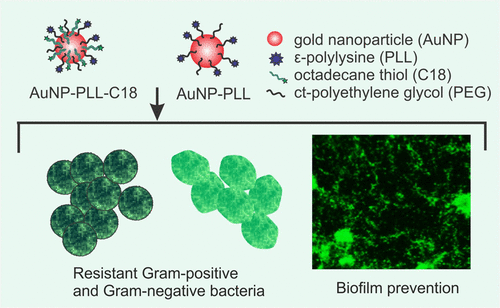当前位置:
X-MOL 学术
›
ACS Appl. Bio Mater.
›
论文详情
Our official English website, www.x-mol.net, welcomes your
feedback! (Note: you will need to create a separate account there.)
ε-Polylysine Nanoconjugates: Value-Added Antimicrobials for Drug-Resistant Bacteria
ACS Applied Bio Materials ( IF 4.6 ) Pub Date : 2020-09-13 , DOI: 10.1021/acsabm.0c00569 Puja Prasad 1 , Rohini Singh 1 , Saipriya Kamaraju 2 , Venkataraman Sritharan 2 , Shalini Gupta 1
ACS Applied Bio Materials ( IF 4.6 ) Pub Date : 2020-09-13 , DOI: 10.1021/acsabm.0c00569 Puja Prasad 1 , Rohini Singh 1 , Saipriya Kamaraju 2 , Venkataraman Sritharan 2 , Shalini Gupta 1
Affiliation

|
Antimicrobial resistance poses a serious threat to human health and is evidently not restricted to any one part of the globe. Over the last few decades, no new antibiotics have been discovered, and many antibiotics currently available are failing against several critical pathogenic strains due to emerging drug resistance. We have designed a strategy to combat deadly drug-resistant bacteria by using nanocargos that consist of gold nanoparticles (AuNPs) conjugated to ε-polylysine (PLL) and octadecanethiol (C18) either alone or in combination. These nanocargos when tested against reference strains of carbapenem-resistant Acinetobacter baumannii (CRAB) and methicillin-resistant Staphylococcus aureus (MRSA) showed 15–20-fold higher antibacterial activity compared to free PLL. The minimum inhibitory concentration (MIC) of the nanoconjugates was found to lie between 8 and 15 μg/mL for both these bacteria, and they were also found to be nonhemolytic and nontoxic to mammalian cells. The mechanistic evaluation of antibacterial action showed alternate pathways of uptake for free PLL and the nanoconjugates. Further, the nanocargos were successfully used and found to be superior to free PLL in preventing biofilm formation in MRSA and CRAB. The PLL nanoconjugates may find applications in prevention of bacterial biofilm formation on surfaces such as surgical instruments and indwelling devices like stents, catheters, cannulas, orthopedic implants, and pacemakers.
中文翻译:

ε-聚赖氨酸纳米偶联物:耐药细菌的增值抗菌剂
抗菌素耐药性对人类健康构成严重威胁,而且显然不限于全球任何一个地方。在过去的几十年里,没有发现新的抗生素,而且由于新出现的耐药性,目前可用的许多抗生素都无法对抗几种关键的致病菌株。我们设计了一种策略来对抗致命的耐药细菌,方法是使用由与 ε-聚赖氨酸 (PLL) 和十八烷硫醇 (C18) 单独或组合结合的金纳米颗粒 (AuNP) 组成的纳米颗粒。这些纳米货物在针对耐碳青霉烯类鲍曼不动杆菌(CRAB) 和耐甲氧西林金黄色葡萄球菌的参考菌株进行测试时(MRSA) 的抗菌活性是游离 PLL 的 15-20 倍。发现纳米缀合物对这两种细菌的最小抑制浓度 (MIC) 介于 8 和 15 μg/mL 之间,并且还发现它们对哺乳动物细胞是非溶血性和无毒的。抗菌作用的机制评估显示了游离 PLL 和纳米缀合物的替代吸收途径。此外,纳米货物被成功使用并被发现在防止 MRSA 和 CRAB 中的生物膜形成方面优于游离 PLL。PLL 纳米缀合物可用于防止表面上的细菌生物膜形成,例如手术器械和留置装置,例如支架、导管、插管、骨科植入物和起搏器。
更新日期:2020-10-21
中文翻译:

ε-聚赖氨酸纳米偶联物:耐药细菌的增值抗菌剂
抗菌素耐药性对人类健康构成严重威胁,而且显然不限于全球任何一个地方。在过去的几十年里,没有发现新的抗生素,而且由于新出现的耐药性,目前可用的许多抗生素都无法对抗几种关键的致病菌株。我们设计了一种策略来对抗致命的耐药细菌,方法是使用由与 ε-聚赖氨酸 (PLL) 和十八烷硫醇 (C18) 单独或组合结合的金纳米颗粒 (AuNP) 组成的纳米颗粒。这些纳米货物在针对耐碳青霉烯类鲍曼不动杆菌(CRAB) 和耐甲氧西林金黄色葡萄球菌的参考菌株进行测试时(MRSA) 的抗菌活性是游离 PLL 的 15-20 倍。发现纳米缀合物对这两种细菌的最小抑制浓度 (MIC) 介于 8 和 15 μg/mL 之间,并且还发现它们对哺乳动物细胞是非溶血性和无毒的。抗菌作用的机制评估显示了游离 PLL 和纳米缀合物的替代吸收途径。此外,纳米货物被成功使用并被发现在防止 MRSA 和 CRAB 中的生物膜形成方面优于游离 PLL。PLL 纳米缀合物可用于防止表面上的细菌生物膜形成,例如手术器械和留置装置,例如支架、导管、插管、骨科植入物和起搏器。











































 京公网安备 11010802027423号
京公网安备 11010802027423号